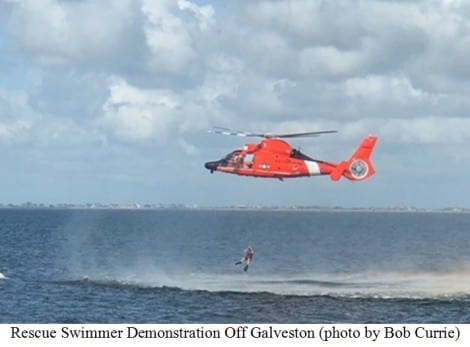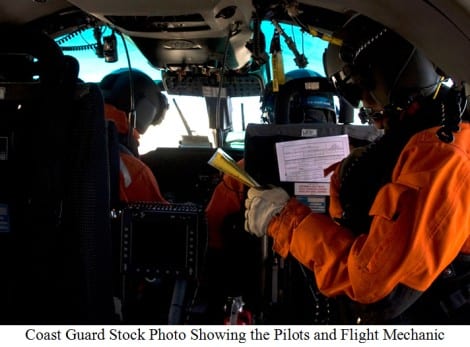 By Bob Currie, Vessel Examiner
By Bob Currie, Vessel Examiner
United States Coast Guard Auxiliary Station Galveston Flotilla.
I spent all day Saturday in a mandatory Coast Guard Auxiliary operations workshop at Sector Houston-Galveston (Ellington Field). The attendees included representatives from all of our Division 6 flotillas, including the air flotilla. The purpose was to go over Coast Guard expectations for Auxiliary support of both surface and air operations.
The Station Galveston Flotilla of the US Coast Guard Auxiliary operates out of the USCG Station Galveston base on Galveston Island. They provide assistance to the Coast Guard by providing maritime observation patrols in Galveston Bay; by providing recreational boating vessel safety checks; and by working alongside Coast Guard members in maritime accident investigation, small boat training, watch standing, and property administration.
Most of our missions are routine Marine Observation Missions (MOM), but we also are ordered out on Search and Rescue (SAR) missions, Aids to Navigation (ATON) verification missions, regatta support (boat races and parades), and small boat training missions where we work side by side to help train Coast Guard small boat teams. We also perform interagency missions with the Texas Parks and Wildlife Division game wardens and different sheriff department water patrols. The Coast Guard has asked us to take over up to three fourths of the ATON verifying missions. The Houston Ship Channel is now the busiest port in the USA, with over 10,000 ship arrivals in 2018 and over 141,000 barge tow movements. We have over 400 buoys and other ATONs in the channel alone, and they get knocked off location all the time. If you see a damaged ATON, please report it to the Coast Guard.
We all know the Coast Guard has rescue helicopters. During the aftermath of Hurricane Harvey, our helicopters made almost 1,000 rooftop rescues in the Houston area. Part of our workshop involved discussion of how we can assist the air wing, and how rescue operations actually occur. I thought I might share some of that information with you, as you may find yourself in need of being rescued by helicopter.

Coast Guard Air Station Houston Helicopters
The MH-65 helicopter built by Eurocopter America is the U.S. Coast Guard’s primary rescue helicopter. The Dolphin is certified for operation in all-weather and night-time operations, with the exception of icing conditions. There are 100 MH-65s in the inventory. The MH-65 is the primary Coast Guard aircraft used aboard certified cutters during deployments. It can fly up to 15,000 feet at a maximum speed of 165 knots. It has a range of 290 nautical miles. The helicopters are armed with an M107-derived, 0.5 calibre, precision fire weapon and an M240B 7.62mm, general purpose machine gun. Coast Guard Air Station (CGAS) Houston operates three MH-65D helicopters, patrolling an area from the Colorado River at Matagorda Bay, TX, to White Lake, LA, averaging more than 180 Search and Rescue (SAR) missions a year. Their missions include SAR, Homeland Security, Fisheries Enforcement, Environmental Protection, and Maritime Law Enforcement.
FLIR (Forward Looking Infrared), a heads-up display and other avionics upgrades are being installed aboard the MH-65D as part of the ongoing conversion-sustainment initiative to sustain the airframe for the foreseeable future. Furthermore, the re-designation of Airborne Use of Force (AUF) MH-65Cs reflects the installation of armament and a significantly upgraded communications package. The Auxiliary participates in FLIR training exercises with the Dolphins by being the boat they are searching for. These are night exercises, as there is no need for FLIR in the daytime except when it is foggy, and we don’t normally train in the fog.
Helicopter Crew
The crew on a Dolphin includes two pilots, one flight mechanic, and a rescue swimmer. The crews train constantly when not on actual missions.

Rescue Options
The Dolphins have three methods of rescuing persons: sling, basket, and litter. Basically there are two hoisting scenarios. One scenario involves abandoning ship and will most likely involve multiple hoists. The other scenario is a medical evacuation to remove a sick or injured person. In the medical evacuation scenario, the focus is on coordinating the hoist and monitoring the victim’s condition. In either case, there are some basic rules to follow.
Making the Call for Help
If the boat is sinking, issue a Mayday on VHF Channel 16. You must have a marine VHF/FM radio. The noise in the cockpit makes it impossible for the flight crew to talk to you by cell phone. It is important to include in your Mayday call the number of persons aboard, your latitude and longitude, and the nature of your emergency. If you are within 21 miles of shore, the Coast Guard will most likely be able to get a fix on your location. If you plan to go out further than that, you should have personal locator beacons (PLBs) for each person onboard, and an emergency position indicating radio beacon (EPIRB) for your boat. The EPIRB should be freshly registered before leaving the dock. Be prepared to switch to another working frequency such as 21A or 22A when instructed. The rescue operation will not be conducted on channel 16. Remember that VHF radio signals are line of sight, so if you plan to go far offshore, consider renting or purchasing a satellite phone. Once the Coast Guard gets near your boat, all communications will be by marine radio.
Abandoning Ship Scenario
Don PFDs or survival suits, activate chemical lights, strobes or signal lights on the vessel and those attached to PFDs or survival suits. Get your ditch bag ready, including handheld VHF radios, flares, strobe and smoke signals. Assess the situation and describe it to the Coast Guard. Include conditions aboard the boat, including whether the engines are inoperable, the boat is taking on water and if it is listing. This will help the rescue crew determine what supplies to bring along, such as extra pumps and life rafts. Indicate if anyone is sick or injured, and if you have any medical personnel aboard. Ask yourself if abandoning ship is really necessary. If the helicopter crew determines that a direct hoist from the boat cannot be performed safely, you will be asked to get into your raft and cast off from the boat or to enter the water. The rescue swimmer will then enter the water to help hoist you to the helicopter.
Sick or Injured Person Scenario
It is important to relay the severity and extent of any injuries as well as the physical condition of the sick or injured person to the Coast Guard. Not all rescues require the use of the litter, and litter rescues are more hazardous than sling rescues. It is easier for the helicopter to hoist from a moving boat than from a stationary boat. The helicopter crew will instruct you in which direction to head if you can get underway. Have a person who can function as the helmsman. Maintain the heading and speed given as much as possible. The helmsman should pay attention to the speed and heading and not get distracted by the helicopter. The wind direction is often a factor. The pilot will likely approach from the stern with the nose of the helicopter positioned to port. This gives the pilot, who is seated to starboard, the most advantageous view of your boat.
Preparing Your Boat
Prepare the boat as though anticipating a hurricane, keeping in mind that the helicopter can send 60-70 knot winds straight down onto the deck. Stow loose deck equipment such as fenders, cushions, coiled lines, gas cans, and anything that can break free and damage the helicopter rotors or become a projectile. Secure hatches and lower flags. Remove your hat as it could be sucked up into the helicopter engines and create problems. Wear goggles if possible, as the boat will be engulfed in a heavy mist created by the rotor wash.
Hoists from the Deck
If the rescue is from the deck, wait for the signal from the helicopter crew to enter the basket. Never attach a line to the basket, the hoist, or the rescue hook on the end of the hoist to any part of the basket. This could result in damage to the hoist cable, or cause a snag that snaps the cable, or even causing the helicopter to crash. Once the basket is winched to the helicopter door, wait until the basket is swung into the craft before attempting to get out. Let the swimmer board your boat from the stern without interference. Don’t try to be too helpful- listen to instructions carefully. If you want to help, put a ladder over the side and toss a heavy mooring line overboard with a life ring or life jacket attached. Thin line can cut through the swimmer’s gloves. If the deck is spacious, the rescue swimmer will be lowered directly aboard and will direct loading an injured person into a rescue litter.
Static Electricity
During hoist operations, static electricity discharge is a common phenomenon between the surface (water, ground, or vessel) and the hoisting device. There are environmental conditions that can cause the development of substantial electrical fields. These conditions include widespread and low thick ceilings, electrical storms forming nearby, and calm sea states. The area where electrical fields meet the surface (water or ground) is referred to as the boundary layer. Over open water, this boundary layer tends to be more conducive to static discharge release than over land. In fair weather or higher sea states, these electric fields are significantly less due to the continual disturbances of the water surface in the boundary layer. There is no exact methodology for predicting when substantial electrical fields exist, only more probable conditions as described above. The important thing to remember is that any device lowered to your boat or the water should not be touched until the device touches the surface of the water or your deck so that any static electricity is discharged.
Summary
The more you know about what to expect happen during a helicopter rescue, the safer the rescue will be. Always have the proper equipment aboard, including PFDs for all persons and a marine VHF/FM radio. If traveling far offshore, include a satellite phone in your standard equipment list. Although commercial vessels are required to have immersion suits, personal beacons, and other emergency equipment, those items are recommended for any vessel that travels far offshore. If you need to contact the Coast Guard for an emergency rescue, be sure to give them as much pertinent information as possible.
For more information on boating safety, please visit the Official Website of the U.S. Coast Guard’s Boating Safety Division at www.uscgboating.org. Questions about the US Coast Guard Auxiliary or our free Vessel Safety Check program may be directed to me at [email protected]. I am available to perform free Vessel Safety Checks, and I will come to your location to perform them. SAFE BOATING!
[3-25-2019]

 Posted in
Posted in 























